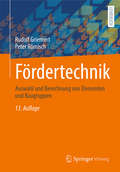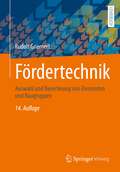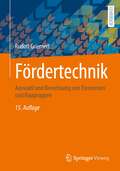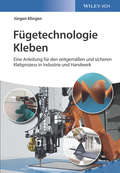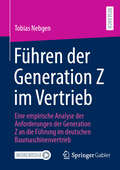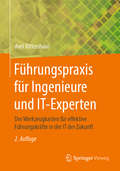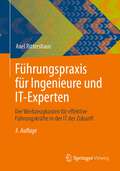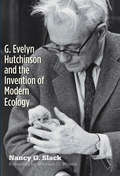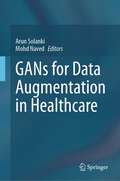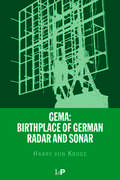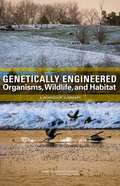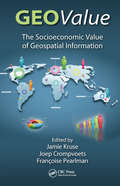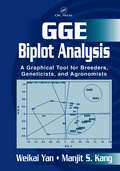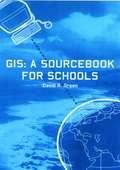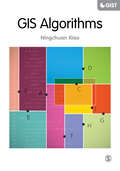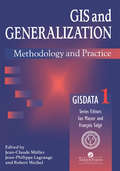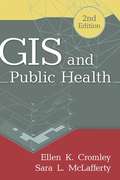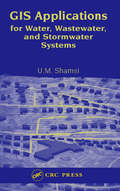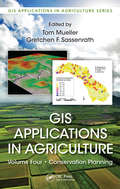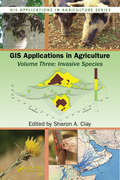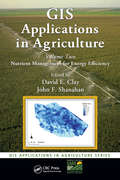- Table View
- List View
Fördertechnik: Auswahl und Berechnung von Elementen und Baugruppen
by Peter Römisch Rudolf GriemertTransport-, Umschlag- und Lagermittel erfolgreich konstruieren, richtig auslegen und korrekt berechnen, das sind Merkmale dieses Lehrbuchs. Normen und Richtlinien helfen bei der Recherche und praxisnahe durchgerechnete Beispiele helfen nachhaltig beim Verständnis für den Lernstoff. Die aktuelle Auflage wurde vollständig überarbeitet sowie um neue Beispiele ergänzt.
Fördertechnik: Auswahl und Berechnung von Elementen und Baugruppen
by Rudolf GriemertTransport-, Umschlag- und Lagermittel erfolgreich konstruieren, richtig auslegen und korrekt berechnen, das sind Merkmale dieses Lehrbuchs. Normen und Richtlinien helfen bei der Recherche und praxisnahe durchgerechnete Beispiele helfen nachhaltig beim Verständnis für den Lernstoff. Die aktuelle Auflage wurde vollständig überarbeitet, Normen wurden aktualisiert und es wurden weitere Aufgaben und Musterlösungen ergänzt.
Fördertechnik: Auswahl und Berechnung von Elementen und Baugruppen
by Rudolf GriemertTransport-, Umschlag- und Lagermittel erfolgreich konstruieren, richtig auslegen und korrekt berechnen, das sind Merkmale dieses sehr gut eingeführten Lehrbuchs. Normen und Richtlinien helfen bei der Recherche und praxisnahe durchgerechnete Beispiele unterstützen nachhaltig das Verständnis für den Lernstoff. Die aktuelle Auflage wurde vollständig durchgesehen, Normen wurden aktualisiert und es wurden zwei weitere Aufgaben mit Musterlösungen ergänzt.
Fügetechnologie Kleben: eine Anleitung für den zeitgemässen und sicheren Klebprozess in Industrie und Handwerk
by Jürgen KlingenKleben gehört zu den wärmearmen Fügetechniken und ist in der Lage, praktisch alle technisch nutzbaren Werkstoffe miteinander und untereinander flächig und stoffschlüssig zu verbinden. Die hierbei durch Adhäsion entstehende Verbindung wird sehr schonend aufgebaut, da der Klebvorgang weder großer Hitze (wie beim Schweißen oder Löten), noch strukturschwächende Löcher (wie beim Nieten oder Schrauben) bedarf. Die in der Regel großflächig ausgelegte Klebung sorgt zudem für eine relativ gleichmäßige Spannungsverteilung im Bauteil. In einem klar strukturierten 5-Phasensystem bietet Fügetechnologie Kleben hier eine detaillierte Anleitung für die Schritte, die für den Aufbau eines sicheren und stabilen Klebprozesses zur Herstellung eines qualitativ hochwertigen Bauteils notwendig sind. Berücksichtigt werden dabei unter anderem die Vorbehandlung der zu verklebenden Werkstoff oberflächen, die Auswahl der geeigneten Klebstoffe, die Dimensionierung der Verklebung sowie die Prozessschritte zur Dosierung beziehungsweise Aushärtung der Klebstoffe. Dem Anwender werden so moderne und nachhaltige Materialien sowie klebtechnische Verfahren präsentiert, mit einem besonderen Fokus auf Oberflächenbehandlungsmöglichkeiten, Klebstoffe und Verarbeitungsmethoden relevant für Industrie und Handwerk.
Führen der Generation Z im Vertrieb: Eine empirische Analyse der Anforderungen der Generation Z an die Führung im deutschen Baumaschinenvertrieb
by Tobias NebgenDas vorliegende Buch geht der Forschungsfrage nach, ob Vertriebsorganisationen von Unternehmen, die sich auf Baumaschinen auf dem deutschen Markt spezialisiert haben, die Bedürfnisse und Erwartungen der Generation Z erfüllen können. Zur Beantwortung dieser Fragen wurde eine empirische Studie durchgeführt, bei der Experteninterviews und Befragungen von Führungskräften und Personen der Generation Z zur Überprüfung der Hypothesen eingesetzt wurden. Die Ergebnisse dieser Studie zeigen, dass ein wettbewerbsfähiges Gehaltsmodell als auch ein verbessertes Work-Life-Balance-Modell signifikante Auswirkungen auf einen Arbeitgeberwechsel haben können.
Führung, Kommunikation und Teamentwicklung im Bauwesen: Grundlagen – Anwendung – Praxistipps
by Brigitte Polzin Herre WeiglWenn auf einer Baustelle Termine nicht eingehalten werden, Pannen sich häufen oder das Budget überschritten wird, hat dies oft zwischenmenschliche Ursachen. Neben dem technischen Wissen entscheidet der Führungsstil von Bauleitern, Architekten und Betriebsinhabern über Erfolg oder Misserfolg einer Bauunternehmung. Das richtige Führungsverhalten verbessert die Zusammenarbeit mit Auftraggebern und Subunternehmern, löst und vermeidet Konflikte und führt das Team zum größtmöglichen Erfolg. Praxisorientiert vermittelt dieses Fachbuch die relevanten Grundlagen der Führung, Kommunikation und Teamentwicklung und bereitet auch Studierende der Fachrichtung Bauwesen auf ihre zukünftigen Führungsaufgaben vor. In der 3. Auflage wurde Kapitel 1 um Lean Management und Kapitel 2 um Lean Leadership ergänzt. Kapitel 5 Kommunikationsmethoden wurde erweitert um die Moderationstechnik Six thinking hats und die Entscheidungstechnik Nutzwertanalyse. Kapitel 6 Change Management wurde aktualisiert und ergänzt um ein Beispiel zur Einführung von Lean Management.
Führungspraxis für Ingenieure und IT-Experten: Der Werkzeugkasten für effektive Führungskräfte in der IT der Zukunft
by Axel RittershausDas Buch geht auf die konkreten Probleme der Führung in der IT ein, räumt mit überholten Standardlehren auf und konzentriert sich auf die Fähigkeiten der IT-Führungskraft der Zukunft. Der Leser erhält sofort umsetzbare Handlungsempfehlungen, die durch Fallbeispiele auf Basis von Interviews mit IT-Führungskräften internationaler Unternehmen ergänzt werden.Wenn Sie es als IT-Führungskraft satt haben, dass die IT als Kostenfaktor statt als Business Enabler gesehen wird, wenn Sie überzeugt sind, dass die IT der Zukunft eine ganz andere Arbeits- und Führungsweise erfordert, wenn Ihre IT nicht mehr als Handlanger zur sinnbefreiten Kennzahlen-Generierung missbraucht, sondern als innovativer Partner des Business akzeptiert werden soll, dann ist dieses Buch genau das Richtige. Wollen Sie jedoch weitermachen wie bislang, ist es nichts für Sie.
Führungspraxis für Ingenieure und IT-Experten: Der Werkzeugkasten für effektive Führungskräfte in der IT der Zukunft
by Axel RittershausDas Buch geht auf die konkreten Probleme der Führung in der IT ein, räumt mit überholten Standardlehren auf und konzentriert sich auf die Fähigkeiten der IT-Führungskraft der Zukunft. Der Leser erhält sofort umsetzbare Handlungsempfehlungen, die durch Fallbeispiele auf Basis von Interviews mit IT-Führungskräften internationaler Unternehmen ergänzt werden.Wenn Sie es als IT-Führungskraft satt haben, dass die IT als Kostenfaktor statt als Business Enabler gesehen wird, wenn Sie überzeugt sind, dass die IT der Zukunft eine ganz andere Arbeits- und Führungsweise erfordert, wenn Ihre IT nicht mehr als Handlanger zur sinnbefreiten Kennzahlen-Generierung missbraucht, sondern als innovativer Partner des Business akzeptiert werden soll, dann ist dieses Buch genau das Richtige. Wollen Sie jedoch weitermachen wie bislang, ist es nichts für Sie.
G. Evelyn Hutchinson and the Invention of Modern Ecology
by Nancy G. SlackStephen J. Gould declared G. Evelyn Hutchinson the most important ecologist of the twentieth century. E.O. Wilson pronounced him "one of the few scientists who could unabashedly be called a genius." In this fascinating book, Nancy G. Slack presents for the first time the full life story of this brilliant scientist who was also a master teacher, a polymath, and a delightful friend and correspondent. Based on full access to Hutchinson's archives and extensive interviews with him and many who knew him, the author evaluates his important contributions to modern ecology and his profound influence as a mentor. Filled with information available nowhere else, the book draws a vibrant portrait of an original scientific thinker who was also a man of remarkable personal appeal.
G. V. Schulz: Leben und Forschen eines Polymer-Pioniers im 20. Jahrhundert
by Sebastian SeiffertProf. Dr. Günther Viktor Schulz, ein bedeutender Wissenschaftler des 20. Jahrhunderts, prägte ganz wesentlich das Gebiet der Polymerchemie. Sein Leben und Wirken in den Wirren dieser Epoche war erfüllt von wissenschaftlichen Entdeckungen und schicksalhaften Begegnungen. Das vorliegende Werk stellt eine private Niederschrift seiner persönlichen Lebens- und Arbeitserinnerungen bereit.
GANs for Data Augmentation in Healthcare
by Arun Solanki Mohd NavedComputer-Assisted Diagnostics (CAD) using Convolutional Neural Network (CNN) model has become an important technology in the medical industry, improving the accuracy of diagnostics. However, the lack Magnetic Resonance Imaging (MRI) data leads to the failure of the depth study algorithm. Medical records often different because of the cost of obtaining information and the time-consuming information. In general, clinical data are unreliable, the training of neural network methods to distribute disease across classes does not yield the desired results. Data augmentation is often done by training data to solve problems caused by augmentation tasks such as scaling, cropping, flipping, padding, rotation, translation, affine transformation, and color augmentation techniques such as brightness, contrast, saturation, and hue.Data Augmentation and Segmentation imaging using GAN can be used to provide clear images of brain, liver, chest, abdomen, and liver on MRI. In addition, GAN shows strong promise in the field of clinical image synthesis. In many cases, clinical evaluation is limited by a lack of data and/or the cost of actual information. GAN can overcome these problems by enabling scientists and clinicians to work on beautiful and realistic images. This can improve diagnosis, prognosis, and disease. Finally, GAN highlights the potential for location of patient information with data. This is a beneficial clinical application of GAN because it can effectively protect patient confidentiality. This book covers the application of GANs on medical imaging augmentation and segmentation.
GEMA: Birthplace of German Radar and Sonar
by Harry von KrogeIn Germany, the development of the first technologies of sonar and radar were interrelated. Following Christian Hulsmeyer's forgotten invention of the "Telemobiloskop" in 1904, two Berlin engineers, Paul Gunther Erbsloh and Hans-Karl von Willisen, developed and built devices to locate targets accurately by reflections with underwater sound and radi
GENETICALLY ENGINEERED Organisms, Wildlife, and Habitat: A WORKSHOP SUMMARY
by National Research Council of the National AcademiesSince the first commercial introduction of transgenic corn plants in 1995, biotechnology has provided enormous benefits to agricultural crop production. Research is underway to develop a much broader range of genetically engineered organisms (GEOs), including fish, trees, microbes, and insects, that could have the potential to transform fields such as aquaculture, biofuels production, bioremediation, biocontrol, and even the production of pharmaceuticals . However, biotechnology is not without risk and continues to be an extremely controversial topic. Chief among the concerns is the potential ecological effects of GEOs that interact with wildlife and habitats. The U.S. Geological Survey (USGS) is charged with providing scientific advice to inform federal agencies that manage wildlife and their habitats. USGS has identified biotechnology as one of its major challenges for future research. Seeing an opportunity to initiate a dialogue between ecologists and developers of GEOs about this challenge, the USGS and the National Research Council (NRC) held a two-day workshop in November of 2007, to identify research activities with the greatest potential to provide the information needed to assess the ecological effects of GEOs on wildlife and habitats. The workshop, designed to approach the research questions from a habitat, rather than transgenic organism, perspective, is summarized in this book.
GEOValue: The Socioeconomic Value of Geospatial Information
by Joep Crompvoets Jamie B. Kruse Francoise PearlmanQuantifying the social and economic value that geospatial information contributes to modern society is a complex task. To construct reliable and consistent valuation measures requires an understanding of the sequence of processes that starts with data acquisition, and leads to decision-makers’ choices that impact society. GEOValue explores each step in this complex value chain from the viewpoint of domain experts spanning disciplines that range from the technical side of data acquisition and management to the social sciences that provide the framework to assess the benefit to society. The book is intended to provide foundational understanding of the techniques and complexities of each step in the process. As such it is intended to be assessable to a reader without prior training in data acquisition systems, information systems, or valuation methods. In addition, a number of case studies are provided that demonstrate the use of geospatial information as a critical input for evaluation of policy pertaining to a wide range of application areas, such as agricultural and environmental policy, natural catastrophes, e-government and transportation systems.
GGE Biplot Analysis: A Graphical Tool for Breeders, Geneticists, and Agronomists
by Weikai Yan Manjit S. KangResearch data is expensive and precious, yet it is seldom fully utilized due to our ability of comprehension. Graphical display is desirable, if not absolutely necessary, for fully understanding large data sets with complex interconnectedness and interactions. The newly developed GGE biplot methodology is a superior approach to the graphical analys
GIS
by David R. GreenIn a relatively short time Geographic Information Systems (GIS) have spread from being primarily a research tool to higher and subsequently secondary education, and from the researcher to the user. GIS: A Sourcebook for Schools is an easily accessible guide to GIS at an elementary level and provides sufficient background in GIS to ensure a comprehensive working knowledge of the subject. It is written specifically for schoolteachers looking to incorporate GIS into the secondary school curriculum, and will be the essential textbook for all those wishing to gain an introduction to a working knowledge of GIS.The book contains everything that a teacher wanting to implement GIS into the curriculum would need, including glossary of terms, explanation of the fundamentals, definitions and further reading. No other book will be quite as useful as this one.
GIS Algorithms (SAGE Advances in Geographic Information Science and Technology Series)
by Professor Ningchuan XiaoGeographic information systems (GIS) have become increasingly important in helping us understand complex social, economic, and natural dynamics where spatial components play a key role. The critical algorithms used in GIS, however, are notoriously difficult to both teach and understand, in part due to the lack of a coherent representation. GIS Algorithms attempts to address this problem by combining rigorous formal language with example case studies and student exercises. Using Python code throughout, Xiao breaks the subject down into three fundamental areas: Geometric Algorithms Spatial Indexing Spatial Analysis and Modelling With its comprehensive coverage of the many algorithms involved, GIS Algorithms is a key new textbook in this complex and critical area of geography.
GIS Algorithms (SAGE Advances in Geographic Information Science and Technology Series)
by Professor Ningchuan XiaoGeographic information systems (GIS) have become increasingly important in helping us understand complex social, economic, and natural dynamics where spatial components play a key role. The critical algorithms used in GIS, however, are notoriously difficult to both teach and understand, in part due to the lack of a coherent representation. GIS Algorithms attempts to address this problem by combining rigorous formal language with example case studies and student exercises. Using Python code throughout, Xiao breaks the subject down into three fundamental areas: Geometric Algorithms Spatial Indexing Spatial Analysis and Modelling With its comprehensive coverage of the many algorithms involved, GIS Algorithms is a key new textbook in this complex and critical area of geography.
GIS Algorithms (SAGE Advances in Geographic Information Science and Technology Series)
by Professor Ningchuan XiaoGeographic information systems (GIS) have become increasingly important in helping us understand complex social, economic, and natural dynamics where spatial components play a key role. The critical algorithms used in GIS, however, are notoriously difficult to both teach and understand, in part due to the lack of a coherent representation. GIS Algorithms attempts to address this problem by combining rigorous formal language with example case studies and student exercises. Using Python code throughout, Xiao breaks the subject down into three fundamental areas: Geometric Algorithms Spatial Indexing Spatial Analysis and Modelling With its comprehensive coverage of the many algorithms involved, GIS Algorithms is a key new textbook in this complex and critical area of geography.
GIS And Generalisation: Methodology And Practice
by J. C. MüllerThis text is the inaugural book in Taylor and Francis's GISDATA series, and is derived from the specialist workshop convened under the auspices of the European Science Foundation's GISDATA Scientific Programme. Generalisation is an integrating tool for the analysis and presentation of spatial data. Effective spatial data analysis requires multiple views of the world at various scales with different thematic layers of representation. Generalisation is a key mechanism in this process, as it filters out information which is required for particular scales or layers; hence it is critical to implement full and comprehensive generalisation capabilities in a GIS, something with which few current GIS are equipped.; This book overviews the core and as-yet unresolved issues surrounding the achievement of this goal, and presents various alternatives - both speculative views and practical examples - in the areas of automated generalisation, vis-a-vis problems such as object simplification and placement. At the same time it distinguishes between modelling with generalisation and graphical representation, and adopts a model-building perspective. It also describes artificial intelligence techniques for implementing automated generalised routines, and addresses issues of data quality and production.; The text is organized into six parts: an introduction; generic issue; object-orientated methods and knowledge-based modelling; knowledge acquisition and representation; data quality; and operation and implementation.
GIS And Public Health
by Sara McLafferty Ellen CromleyAuthoritative and comprehensive, this is the leading text and professional resource on using geographic information systems (GIS) to analyze and address public health problems. Basic GIS concepts and tools are explained, including ways to access and manage spatial databases. The book presents state-of-the-art methods for mapping and analyzing data on population, health events, risk factors, and health services, and for incorporating geographical knowledge into planning and policy. Numerous maps, diagrams, and real-world applications are featured. The companion Web page provides lab exercises with data that can be downloaded for individual or course use.
GIS Applications for Water, Wastewater, and Stormwater Systems
by U.M. ShamsiProfessionals involved in the planning, design, operation, and construction of water, wastewater, and stormwater systems need to understand the productivity-enhancing applications of GIS. Inspired by an ASCE-sponsored continuing education course taught by the author, GIS Applications for Water, Wastewater, and Stormwater Systems focuses on t
GIS Applications in Agriculture, Volume Four: Conservation Planning (GIS Applications in Agriculture)
by Tom Mueller Gretchen F. SassenrathConservation planning involves targeted management practices and land use decision-making based on careful analysis of landscape limitations in order to protect soil and water resources. Developing solutions to conservation planning is of worldwide interest due to anticipated population growth, growing demand of feedstocks for biofuels, decreasing
GIS Applications in Agriculture, Volume Three: Invasive Species (GIS Applications in Agriculture)
by Sharon A. ClayWhile many "alien" plant and animal species are purposefully introduced into new areas as ornamentals, livestock, crops, and even pets, these species can escape into other areas and threaten agricultural and native ecosystems causing economic and environmental harm, or harm to human health. Increasingly, scientists are using Geographic Information Systems (GIS) to track and manage the invaders, mitigate the potential rate of spread and level of impact, and protect the native economy and ecosystem.Beginning with an introduction to the use of GIS technology to capture, store, analyze, manage, and present data, GIS Applications in Agriculture, Volume Three: Invasive Species examines five relevant categories of geographic information including dispersal and transport, prediction and forecasting, mapping of current infestations, maps for management and control tactics, and impact assessment and method of control. It address GIS for studying the population ecology of a new species, niche requirements for species success, and the monitoring and control of several different species including Australian examples of intentionally introduced invasive species, insects and other animals that may also vector a disease, and invasive weed management from prediction to management. Chapters cover maps and imageries available on various Web sites and provide step-by-step tutorials or case studies that allow manipulation of datasets featured on the accompanyingdownloadable resources to make maps, perform statistical analyses, and predict future problems. It offers hands-on experience with a variety of software programs that create interactive queries (user-created searches), analyze spatial information, edit data and maps, and present the results of these operations in several different formats. Some of the programs are freeware, others are not, but each can be used to integrate, edit, share, and display geographic information. Color figures are
GIS Applications in Agriculture, Volume Two: Nutrient Management for Energy Efficiency (GIS Applications in Agriculture)
by Michael R. Conover John F. ShanahanWe are entering a new era in production agronomics. Agricultural scientists the world over call for the development of techniques that simultaneously increase soil carbon storage and reduce agriculture's energy use. In response, site-specific or precision agriculture has become the focus and direction for the three motivating forces that are changi
